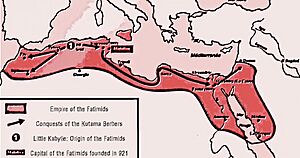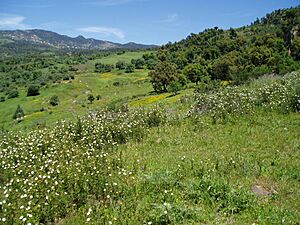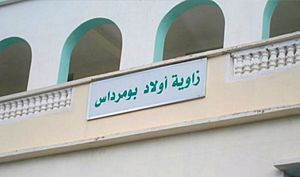Kabylia facts for kids
Quick facts for kids
Kabylia
Tamurt n Yiqbayliyen
منطقة القبائل |
|
|---|---|
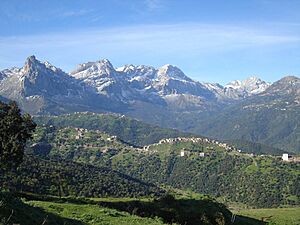 |
|
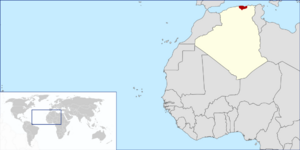
Location of Kabylia in central Algeria (northwestern Africa)
|
|
| Region | |
| Provinces - Wilayas | |
| Area | |
| • Total | 25,000 km2 (10,000 sq mi) |
| Population
(2012)
|
|
| • Total | 3,450,000 |
| • Density | 138.0/km2 (357/sq mi) |
| Demonym(s) | Kabyles Iqbayliyen |
| Time zone | UTC+1 |
| • Summer (DST) | UTC+1 (CEST) |
| Area code | +213 (Algeria) |
| Languages | Kabyle (Kabyle) Arabic French |
Kabylia (also spelled Kabylie) is a beautiful mountainous region located on the coast of northern Algeria. It is the traditional home of the Kabyle people. This area is part of the Tell Atlas mountain range and sits right next to the Mediterranean Sea.
Kabylia includes two important areas of Algeria: Tizi Ouzou and Bejaia. You can also find two national parks here, Gouraya National Park and Djurdjura National Park, which are great for exploring nature.
Contents
What's in a Name?
The name 'Kabylia' was first used during the time when France colonized Algeria. Before the French arrived, the local people, both Arab and Berber, did not use this term.
The word 'Kabyle' comes from the Arabic word qaba'il. This word has a couple of meanings. It can mean 'tribes' that live among settled people. It can also mean 'to accept', which was used for local groups who accepted Islam after the Muslim conquest of the Maghreb.
A Look at Kabylia's Past
Ancient Times
Long ago, Kabylia was part of a kingdom called Numidia. This kingdom existed from 202 BC to 46 BC.
The Middle Ages
The story of Kabylia in old books began around the fourth century AD. This was when a commander named Firmus and his brother Guildon rebelled against the Roman Empire.
Later, a group called the Vandals (from Germany) created a kingdom in North Africa in 435 AD. But they were soon defeated by the Byzantine Empire. During the rule of the Romans, Vandals, and Byzantines, the Kabyle people were one of the few Imazighen (another name for Berbers) in North Africa who managed to stay independent.
Even during the Arab conquest of North Africa, the Kabyles were able to control their mountains for a while. It wasn't until 1857 that France fully conquered Kabylia.
Between 902 and 909 AD, a group of Berbers from Little Kabylie, called the Kutama, helped create the Fatimid Caliphate. They supported Abu Abdallah al-Shi'i in conquering Ifriqiya (an area in North Africa). This led to the start of the Fatimid Caliphate, even though the ruling family was Arab. The Fatimids later expanded their power, conquering areas like Fez and Sijilmassa in Morocco.
The Kutama played a big role in the Fatimid army. However, their influence lessened over time as new groups joined the army. In 969, Fatimid troops conquered Egypt. The Fatimid Caliphate grew to be very large, covering about 4,100,000 square kilometers.
Later, two important Berber families, the Zirids and the Hammadids, became powerful leaders. The Zirids ruled lands in what is now Algeria, Tunisia, Morocco, Libya, Spain, Malta, and Italy. The Hammadids controlled important cities and regions across the Maghreb area (North Africa).
The Regency of Algiers
During the time of the Regency of Algiers, most of Kabylia was independent. It was divided into two main kingdoms: the Kingdom of Kuku (in today's Tizi Ouzou Province) and the Kingdom of Ait Abbas (in today's Béjaïa Province).
French Rule and Resistance
Kabylia was the last area to resist French colonization. Even after 1830, the French gradually took over the region. The local people fought back strongly, led by brave figures like Faḍma n Sumer and Cheikh Mokrani.
A major French victory happened at the Battle of Icheriden in 1857. However, smaller fights continued, like Mokrani's rebellion in 1871. After these uprisings, the French took land from some tribes and gave it to French settlers. Many people were arrested and sent away, some even to New Caledonia. This colonization also caused many Kabyle people to move to other parts of Algeria or even other countries.
In the 1920s, Algerian workers in France started the first group that wanted independence. Leaders like Messali Hadj and Imache Amar gained many followers in France and Algeria. They trained people who became important in the fight for independence.
During the 19th century, French colonists created an idea called the Kabyle myth. This idea suggested that Kabyle people were more likely to adopt "French civilization" than Arabs. This was a way to justify the French presence. However, before the 1840s, Kabyles had already become part of the Arab culture of Algeria over many centuries.
The Algerian War of Independence
During the War of Independence (1954–1962), the FLN and its army, the ALN, organized the country into different areas. For the first time, Kabylia became a unified administrative territory called wilaya III. It was a very important center for the fight against colonial rule.
Because of its mountains and the strong support from its people, Kabylia was one of the most affected regions during the war. Many important leaders of the FLN, like Hocine Aït Ahmed and Krim Belkacem, came from this area. The first FLN meeting, the Soummam conference, also took place in Kabylia in 1956.
However, being so important also meant Kabylia was a main target for French military operations. This led to the destruction of farms, villages, and the displacement of many people.
After Independence
After Algeria gained independence, there were tensions between Kabyle leaders and the new government. The Socialist Forces Front (FFS) party, strong in Kabylia, disagreed with the FLN's leadership. This led to armed conflict in the region for two years, resulting in many deaths. Many FLN leaders from Kabylia were either executed or forced to leave the country.
In April 1980, protests and strikes broke out in Tizi Ouzou. This happened after a talk by writer Mouloud Mammeri about Kabyle poetry was cancelled. These events, known as the Berber Spring, led to demands for the Tamazight language to be officially recognized. Many Kabyle thinkers were imprisoned, and there were more clashes in the following years.
When Algeria became a multi-party system in 1989, the RCD party was formed. At the same time, the Kabyle people's cultural identity became stronger, especially as the government pushed for more Arabic language use.
During a civil war, from 1994 to 1995, the people of Kabylia held a "schoolbag strike." This meant they boycotted schools to protest. In 1998, tensions rose again after the singer and activist Lounès Matoub was killed. This happened when a new law required Arabic to be used in all education.
In April 2001, a young student died in police custody. This sparked major riots known as the Black Spring. Many people died and thousands were injured. Eventually, the government had to talk with the Arouch, which are traditional local councils. These talks covered social justice and economic issues.
Finally, in 2002, Tamazight was recognized as a national language of Algeria. Then, on February 7, 2016, it became an official language of the state, alongside Arabic.
Since 2011, the Movement for the Autonomy of Kabylie (MAK) has called for self-rule for the region. The MAK later changed its name to "Mouvement pour l'Autodétermination de la Kabylie," seeking full independence from Algeria.
Geography of Kabylia
Kabylia has two main parts:
- Greater Kabylia: This area stretches from Thénia in the west to Bejaia in the east. It goes from the Mediterranean Sea in the north to the Soummam Valley in the south. It's about 200 km long and 100 km wide, starting just 50 km from Algiers, the capital of Algeria.
- Lesser Kabylia: This part includes the Kabylia of Bibans and the Kabylia of Babors.
Three large mountain ranges cover most of the region:
- Northern Mountains: These are the mountains along the coast, with Tifrit n'Ait El Hadj (Tamgout) being the highest peak at 1278 meters.
- Southern Mountains: The Djurdjura range dominates the Soummam valley, with Lalla-Khedidja as its highest point at 2308 meters.
- Central Mountains: Between the northern and southern ranges is the Agawa mountain range. This is the most populated area, with an average height of 800 meters. The largest town in Great Kabylia, Tizi Ouzou, is located here. At Iraten (once called "Fort-National") is the highest urban center in the area.
Wildlife and Nature
Kabylia is home to various plants and animals. One special animal found here is the Barbary macaque. This endangered monkey used to live in a much larger area, but now its populations are limited to Algeria, Morocco, and Gibraltar.
The Kabyle People
The people living in Kabylia are called Kabyles. They are a Berber ethnic group. They speak the Kabyle language, which is the largest Berber language spoken in Algeria. About 3 million people speak it. The Kabyle language has been influenced by Arabic, French, Latin, Greek, Phoenician, and Punic languages. Arabic words make up a significant part of its vocabulary.
Since the Berber Spring in 1980, Kabyles have been leading the effort to make the Berber language an official language in Algeria.
Zawiyas: Places of Learning and Spirituality
The Kabylia region has many zawiyas. These are special places, often centers for religious education and community, connected to the Rahmaniyya Sufi brotherhood. Some examples include:
- Zawiya Thaalibia in the Issers.
- Zawiyet Sidi Boumerdassi in Tidjelabine.
- Zawiyet Sidi Boushaki in Thenia.
- Zawiyet Sidi Amar Cherif in Sidi Daoud.
Economy and Industries
The traditional economy in Kabylia was based on growing fruit trees, especially olive trees, and making crafts like tapestry and pottery. Over time, farming in the mountains and hills has slowly given way to local industries, such as textile (cloth making) and agro-alimentary (food processing).
Today, Kabylia is one of the most industrialized parts of Algeria. It produces a good portion of Algeria's economic output, not including oil and gas. Industries here include:
- Pharmaceuticals (medicines) in Bgayet (Bejaia).
- Agro-alimentary (food) in Ifri and Akbou.
- Mechanical industry (machines) in Tizi Ouzou and other towns.
- Petrochemical industry and oil refining in Bgayet (Bejaia).
The port in Bgayet (Bejaia) is the second largest in Algeria and the sixth largest in the Mediterranean Sea.
See also
- JS Kabylie
- Kabylia football team



